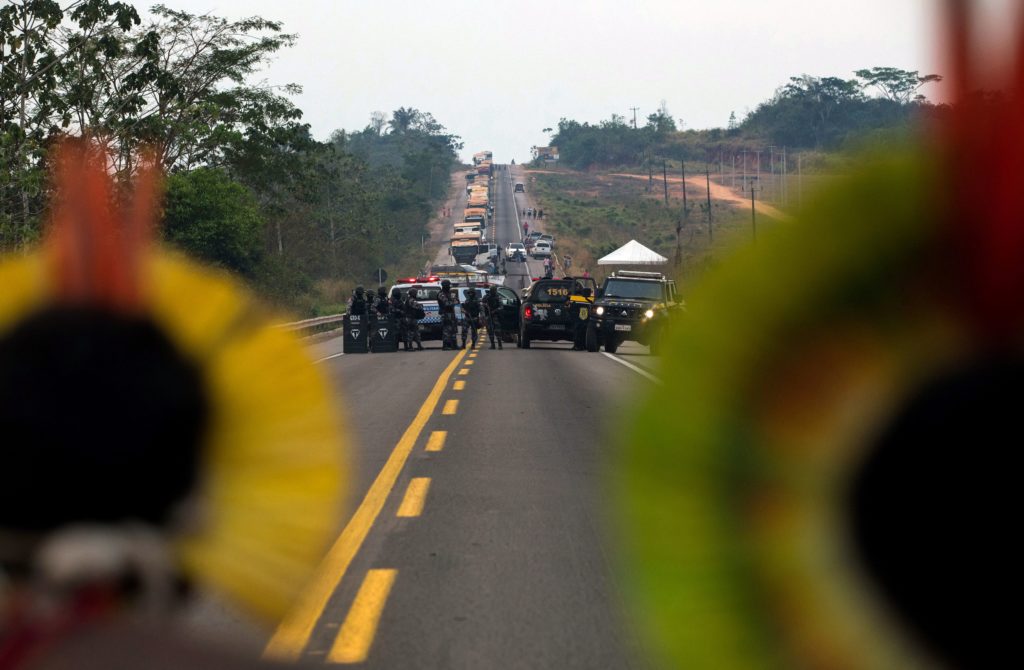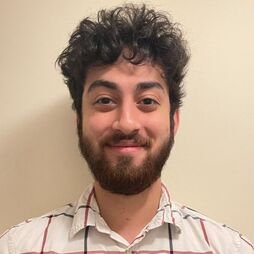“I am afraid.”
Those were the words of Genilson Guajajara, an Indigenous photographer who lives in Piçarra Preta, a small village in the Maranhão state of the Brazilian Amazon rainforest. Guajajara has been chronicling both the beauty and the destruction of the environment around his village and sharing the images online. Yet doing so puts his life at risk by individuals and organizations that conduct illicit activities to exploit the Brazilian Amazon.
“The people defending the environment have received many threats,” said Guajajara. “Not just from the government but from other people as well: farmers, loggers, and miners.”
And Piçarra Preta is not the only village at risk.
Deforestation efforts have left Indigenous communities in the Amazon struggling with displacement and violence for decades. While Indigenous communities are on the frontlines and bear the brunt of the destruction, the whole world is dependent on the future of the Amazon.
The Amazon’s “Tipping Point”
The Amazon rainforest spans 2.7 million square miles––slightly less than the size of the continental United States. It is the most biodiverse region in the world and serves as one of the largest “carbon sinks” on the planet, in that the region absorbs carbon dioxide from the atmosphere at an unmatched rate. Life on our planet relies heavily on the Amazon rainforest to absorb 1–2 billion tons of carbon annually.
The Amazon rainforest is over two million square miles and spans nine countries in South America
However, deforestation trends over the past few decades have led many experts to fear for the future of the Amazon. According to Mongabay, an environmental news site, deforestation in the Brazilian Amazon reached a 12-year high in 2020 as more than 4,000 square miles were cleared––an area about the size of the island of Hawaii.
“The media has been showing that the Amazon has been destroyed and [that] we are facing a major crisis, and that is true to some extent,” said Enrique Ortiz, senior program director of the Andes Amazon Fund. “On the other side, the Amazon still is intact. Probably in the order of 70 to 80 percent of it. So, it is not like the Amazon is destroyed. It’s not, really. There is still quite a large area and [much of] that is thanks to Indigenous territories.”
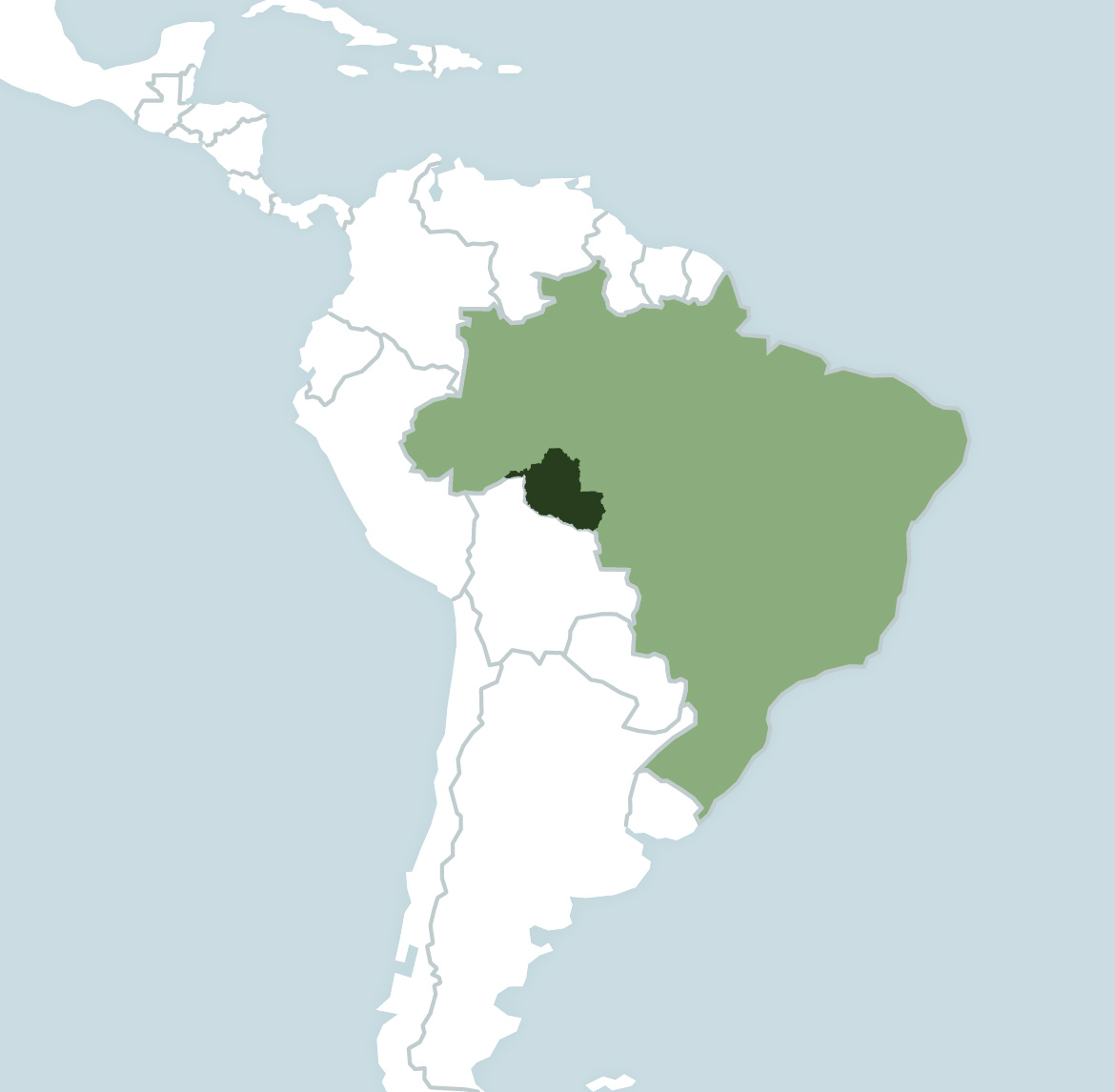
Satellite images of Rondonia, Brazil provide a stark example of deforestation occurring all over the Amazon. Google Earth
The Center for Strategic and International Studies (CSIS) recently published a report, Sustainable Infrastructure in the Amazon, funded by the Gordon and Betty Moore Foundation. The authors underscore that the main contributors to Amazonian deforestation are commercial cattle ranching and soy production, along with activities such as unauthorized gold mining and cocaine production. In Brazil, legal and illegal activities intertwine when squatters level portions of the Amazon, harvest timber, carve out land parcels with fake titles, and then resell the land to commercial operators.
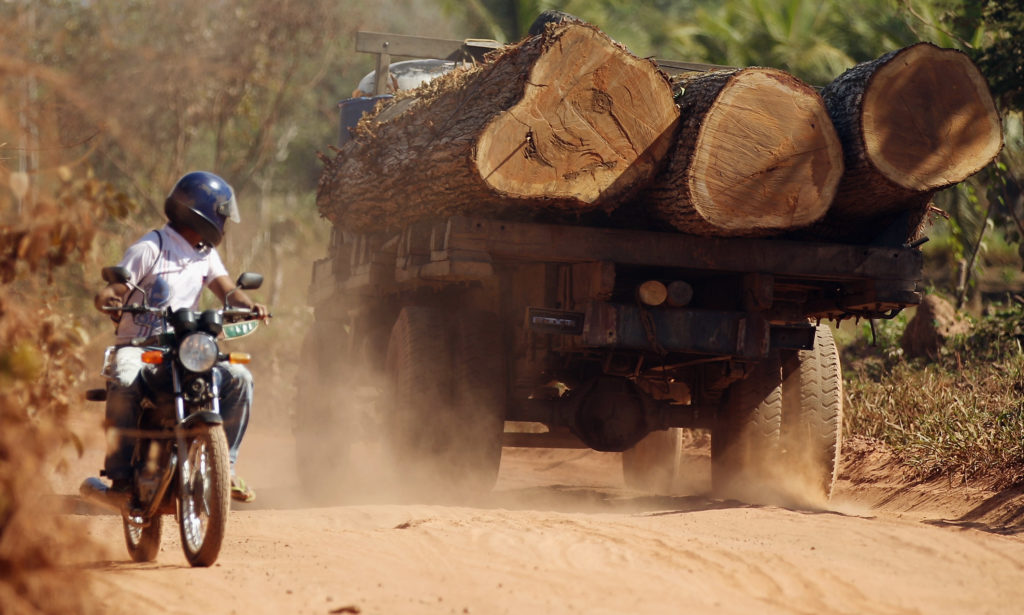
These activities can have devastating impacts on local communities and regional resources. Ortiz called Peru the “poster child” for illustrating the consequences of illegal gold mining, which often pollutes nearby water supplies with methylmercury, a neurological poison for humans, fish, and wildlife. Mining areas are also hotspots for other illegal activity, such as child labor, forced labor, and human trafficking.
“We are probably close to a level that is called ‘the tipping point,’” Ortiz said. “If we don’t stop the current rate of deforestation, the forest loses the ability to produce rain, and that may collapse the world productivity and increase the pace of climate change.”
Protected on Paper
While Amazonian deforestation has global consequences, few people are more affected than the over 400 Indigenous communities who have called the Amazon home for centuries. Most of these communities are protected––on paper––by international treaties, local legislation, and the foundational documents of their respective countries.
The constitution of Brazil guarantees that Indigenous communities control and have access to “the lands they traditionally occupy” or the land necessary for the well-being and preservation of their communities. Likewise, the constitution of Peru states that “the ethnic and cultural diversity” of the nation is preserved by its protection of Indigenous peoples.
The Amazon region contains hundreds of different Indigenous communities, several of which are highlighted here.
Data sources
Yekuana: PIB, Minority Rights; Waiapi: PIB, CNN; Kayapo: PIB, Conservation.org; Munduruku: PIB, MongaBay; Yagua: Peru North, MongaBay; Waorani Nation: Amazon Frontlines, Survival International; The Witoto: Britannica, MongabayPhoto credits
Yekuana:Andressa Anholete via Getty Images; Waiapi: ANDREW ALVAREZ_AFP via Getty Images; Kayapo: Mario Tama via Getty Images; Munduruku: Mario Tama via Getty Images; Yagua: LUIS ROBAYO_AFP via Getty Images; Waorani Nation: RODRIGO BUENDIA_AFP via Getty Images; The Witoto: RICARDO OLIVEIRA_AFP via Getty Images
Although these constitutions explicitly protect these peoples, the political will and capacity of these governments is sometimes weak. Legislation designed to protect and empower Indigenous communities is often inadequate, incomplete, and packed with underfunded mandates.
For example, the 1992 World Bank-funded Pilot Program to Conserve the Brazilian Rainforest (PPG7) had a budget of $428 million and a range of missions. The PPG7 created natural resource policy, established clear boundaries specifying Indigenous territory, and developed research initiatives, allowing Brazil to make significant progress in reducing deforestation and protecting Indigenous lands at the turn of the century. However, new policies enacted in 2012 reversed the environmental progress that had been made. The rate of destruction of the Brazilian Amazon increased from less than 2,860 square miles per year in 2012 to more than 4,660 square miles per year in 2018.
The reversal of protections for the Amazon and its Indigenous lands has continued in Brazil under the leadership of President Jair Bolsonaro. The Brazilian president claims that “where there is Indigenous land, there is wealth underneath it” and has actively sought and promoted commercial development of the Amazon and weakened IBAMA, the environmental regulatory agency of the Brazilian government. Bolsonaro’s minister of the environment, Ricardo Salles, has worked to systematically bypass the National Congress of Brazil to eliminate environmental protections of the Amazon and the communities residing within it.
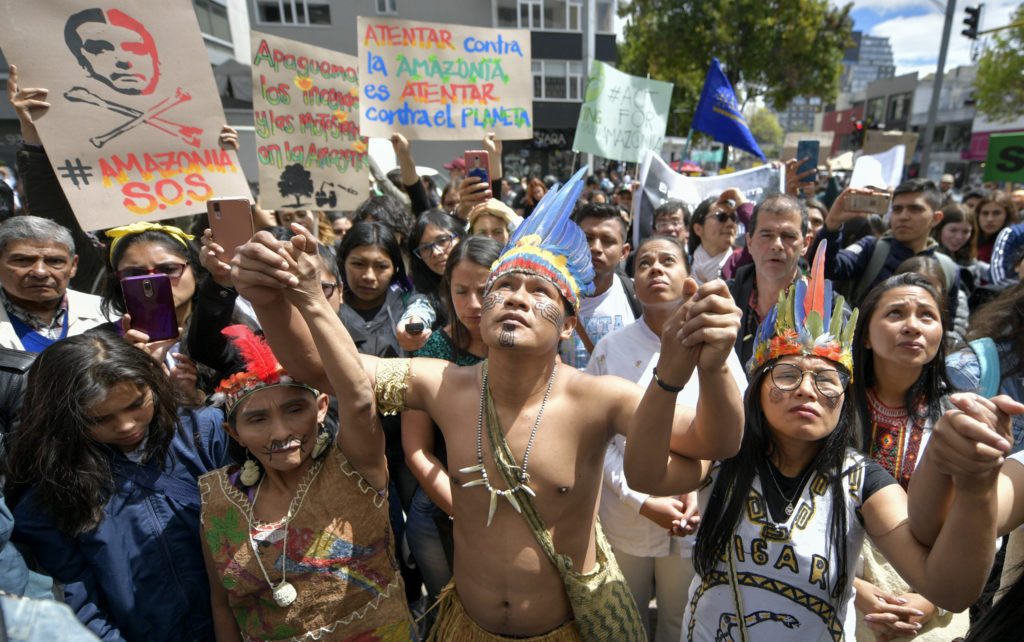
Today, Indigenous and other protected lands cover about 52 percent of the Amazon, though the Amazon Geo-Referenced Socio-Environmental Information Network (RAISG) estimates that 22 percent of those protected lands are threatened by mining and oil projects. RAISG also estimated that 39,768 square miles of protected lands in the Amazon were cut down in protected areas between 2000 and 2015.
One
of the most significant impacts of deforestation is its impact on biodiversity.
Recent studies have shown the importance of protected Indigenous lands in the
fight against loss of biodiversity, in addition to continued displacement and
cultural loss. A 2019 study published in the Environmental
Science and Policy concluded that territories protected by Indigenous
communities across Australia, Canada, and Brazil had the highest biodiversity
levels of the countries’ protected areas. In a 2020 study, researchers Kathryn Baragwanatha
and Ella Bayi concluded that Indigenous communities are effective in countering
deforestation primarily when granted full property rights.
Into Their Own Hands
In the absence of effective enforcement of existing environmental laws and property rights, Indigenous communities work to protect the Amazon themselves.
“What’s there [in the rainforest] is the result of a historical fight by our ancestors,” said Guajajara. “And she [the rainforest] is also like our mother, who gives us attention, sustenance, [and] takes care of our health. We don’t need to deforest her to survive because she already gives us sustenance.”
Guajajara and his community, and this forest they rely on, are losing that decades-old fight for protection; land grabbing—the invasion of public areas, often with the aid of often forged documents certifying possession—occurs increasingly often in many Amazonian communities. Some Latin American countries, such as Brazil, do not consolidate all municipal, state, and federal landowner records. This makes it easier for land grabbers to use intimidation tactics such as setting fire to Indigenous and rural Amazonian communities to force them to release their land claims. The illegally-obtained land is then used for development that further increases deforestation of the region.
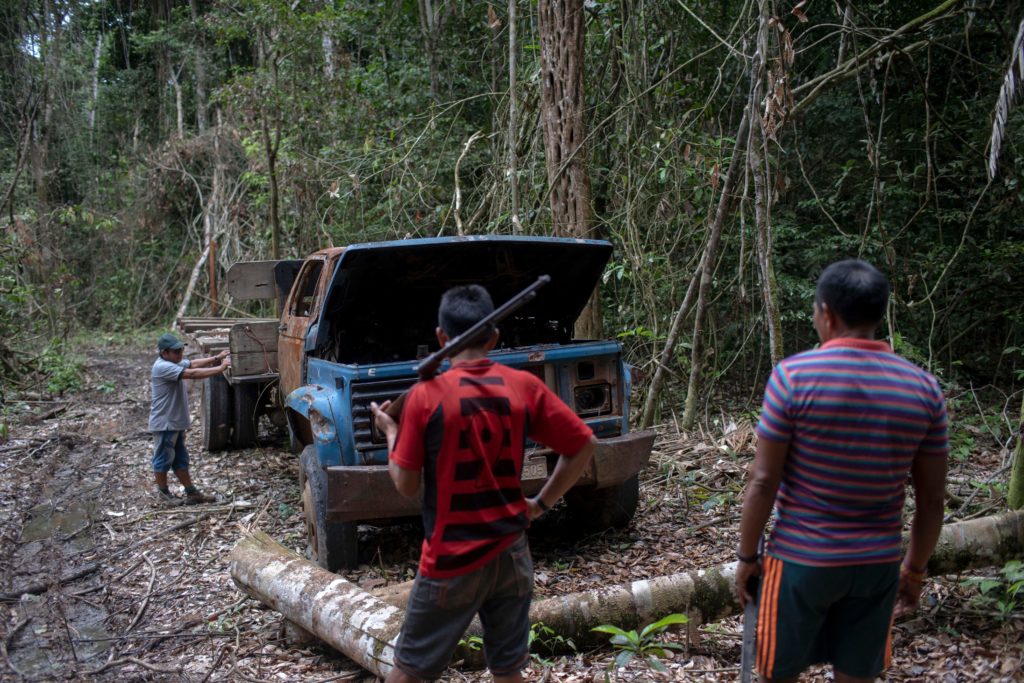
In recent years, groups of Indigenous individuals have patrolled their lands, identifying and confronting illegal activity. One of the most well-known groups is the Guajajara “Forest Guardians” in Brazil. They are often armed with rifles and handguns, which they use to protect themselves and to detain trespassers, whom they sometimes deliver to federal police stations.
Many believe that if such communities don’t step up, they could be increasingly vulnerable to illegal deforestation. “The people here who are in this fight carry it forward,” Genilson Guajajara said.
Violent standoffs between Amazonian Forest Guardians and trespassers are common. A team of journalists identified 1,291 episodes of violence against environmental leaders and their communities between 2009 and 2019, with more than 70 percent of them occurring in Brazil—a figure that almost certainly underrepresents such incidents.
Many of these incidents have been fatal. Between 2000 and 2018, 42 Guajajara Indigenous people were murdered while patrolling their land. In November 2019, the Guajajara community made international news when one of their leaders, Paulo Paulino Guajajara, was shot and killed in an ambush by illegal loggers on Guajajara land.
The direct correlation between the Amazon’s biodiversity and Indigenous livelihoods forces many Indigenous communities to take action to save the forest they depend upon. In addition to covering immediate needs such as food, the variety of life it hosts is culturally important to many Indigenous communities and supports nature-informed spiritual, ancestral, and physical connections and values.
“I’m not sure how to say it, but us Indigenous people have a very close connection with nature because it is a space to live, play, [and] to harvest food,” said Genilson Guajajara, reflecting upon the necessity of biodiversity for Indigenous health and tradition. “There are many great things that we need to leave for new generations, for our children, our grandchildren, our future.”
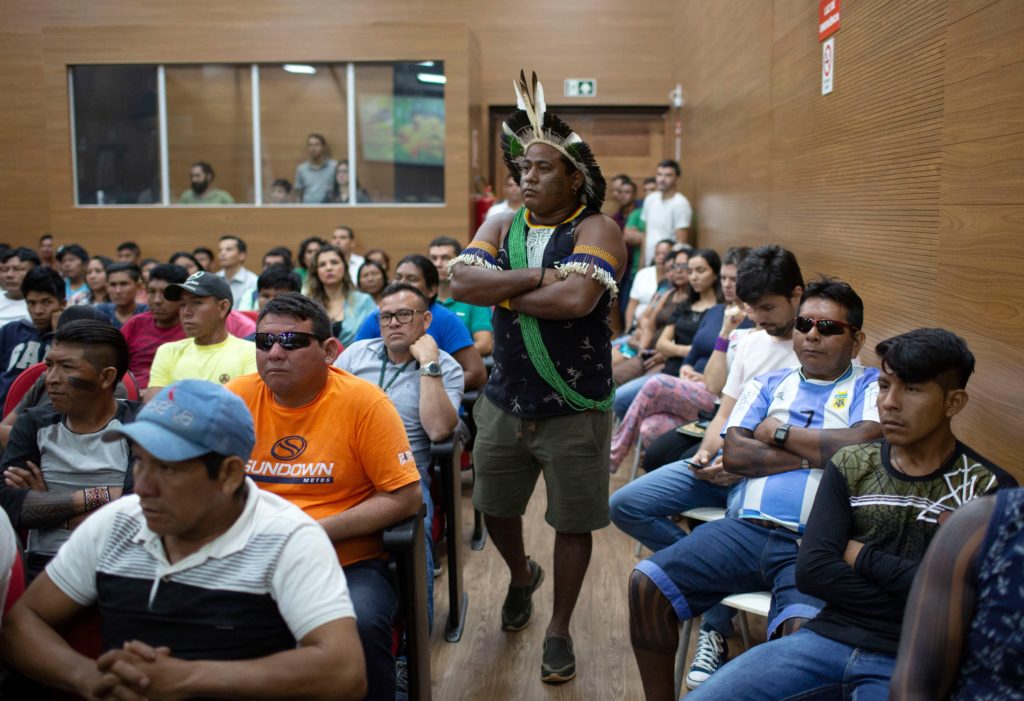
While the rate of forest loss is alarming (over 17 percent—almost 460,000 square miles—of the forest has been lost in the last 50 years), it’s driving the loss of Indigenous culture as well. The cultural loss projected if environmental and Indigenous-centered policy is not fully implemented by Amazonian governments is immense.
“Cultural extinction is way higher than biological extinction. In other words, the rate that we are losing cultures, meaning languages, is much higher than the rate we’re losing species,” Ortiz said. “The connection between culture and forest is direct.”
Eyes in the Sky
Recognizing the challenges that Indigenous communities face in trying to protect their lands, some environmental non-governmental organizations have sought to partner with them.
Amazon Frontlines is one such example. The non-profit focuses on capacity building for local communities in technology and documentary skills. This includes sharing devices for GPS mapping of Indigenous territories to help communities gain governmental recognition of their land.
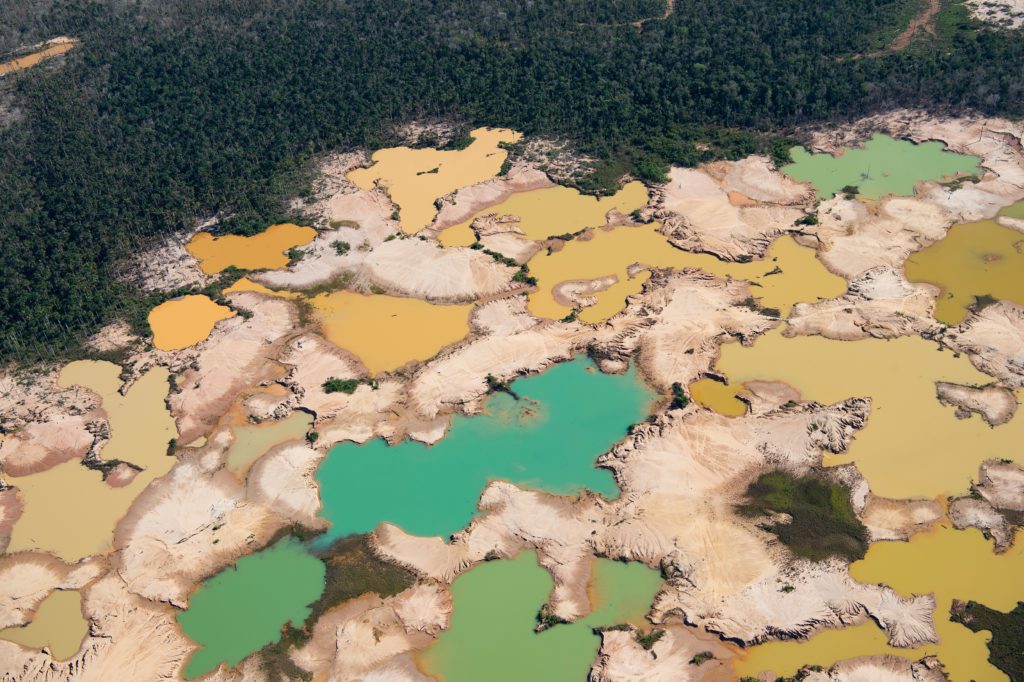
“The strategy . . . is really to prove that Indigenous peoples have been using that territory for generations, they have some sort of ancestral connection to it, spiritual connection, and cultural connection, and that the territory is not just something you can extract from, but something that they’re in deep relation to,” said Ina Shkurti, the land protectors lead of Amazon Frontlines. Territorial protection ensures Indigenous communities’ access to lands that allow those cultures to thrive, says Shkurti.
Amazon Frontlines works in the western Amazon and partners with the Indigenous-led Ceibo Alliance of Ecuador. Shkurti emphasizes the importance of communication and clear goals when facing various cultural and territorial barriers.
“Really the fight for property title is a fight for autonomy and self-determination, and a fight for consent to be asked—not just to be asked but to be heard,” she said.
Another organization, Amazon Conservation, leverages satellite technology to identify illegal logging and mining operations and to monitor the effectiveness of environmental policies through its Monitoring the Andean Amazon Project (MAAP).
According to John Beavers, executive director of Amazon Conservation, the information provided by these technologies can help Indigenous communities to more effectively advocate for policy reforms.
“These communities didn’t really have an easy conduit to be able to go and connect to the government and tell the government, ‘Hey, I’m being invaded’ or ‘I’m being threatened’ or ‘My property is being wiped out,’” Beavers said. “Part of this [monitoring technology] is that with with the information that these communities themselves are able to build and produce, [they can] go to the government … [and] put in a complain that’s actually going to move through the system.”
“We hope that they [the trespassers] stay far away from the territories. That’s what we all hope for,” Guajajara said. “That this right that we all have, this right that guarantees preservation, wouldn’t just be respected but that it would work.”
Unified Action
Ground-up solutions such as these technological innovations are significant. However, the Amazon is a shared resource, and responses to common problems must be coordinated and widespread.
There have been various in-country efforts to respond to the environmental crisis. For example, in 2019 the Peruvian government declared martial law in the city of La Pampa, an area in the Madre de Dios Region of the Peruvian Amazon—one of the epicenters of illegal mining. They then expelled 5,000 miners through a plan called Operation Mercury. This effort reduced illegal mining by 92 percent compared to the previous year.
Regional efforts to collaborate across national borders have also been initiated. On September 6, 2019, seven Amazon countries signed the Leticia Pact, pledging a united effort in conservation of the rainforest. One element of this pact is strengthening Indigenous communities’ “capacities and participation” in “the sustainable development of the Amazon region.” However, critics say that the pact is just a political show, and the vague language promises little action.
“There is not really much of a unified action plan put in place,” Ortiz said. “I don’t see that changing for the moment. Unfortunately, I think it has to be more of a bilateral thing than a Pan-Amazonian thing.”
Internationally, there are calls for condemnation of rainforest destruction and propositions for consumer boycotts on products that harm the Amazon. Juan Cruz, a senior adviser for the CSIS Americas Program, said this is possible in the United States in the market for illegal hardwoods and proposed that the United States use tags on hardwoods to show which products may be from illegal practices.
But Cruz warned that international action must be based on knowledge of people on the ground in the Amazon and the governments that preside over the area or it could do more harm than good. He cautioned against international condemnation of country actions that could backfire.
“Then candidate Biden said something about climate change in Brazil, and he said it probably the worst way you can say to Brazilians, which is to call them out in public and say something like that,” he said. “That’s not how the Brazilians work. That’s how not to do it.”
“I hope this never happens again”
While he acknowledges the many challenges of protecting the rainforest, Enrique Ortiz rejects the “doomsday approach,” emphasizing the opportunities available to protect the majority of the Amazon rainforest that is still standing.
“I am very critical when I see the news and the advertisements saying, ‘the Amazon is going,’” he said. “The truth is that we have some time, but this is the time. Ten years from now it will be too late, so there is still hope.”
But Guajajara doesn’t feel like time is on his side. For his people, and many other Indigenous communities, the window for action is closing fast. While people around the world are still watching smoke from Amazonian fires cloud the skies of distant cities, Indigenous communities face challenges from all sides that threaten the future of their culture and families. For them, the question of the future of the Amazon is a question of their cultures and communities’ survival.
“It’s very hard to see a river that previously served as a bathing place for people, for fishing—to survive off it—being destroyed,” said Guajajara. “When you destroy those things, this forest, you also destroy the life of the people who depend on it. I hope, in the future, this never happens again to a community. And that they have peace within their homes.”
